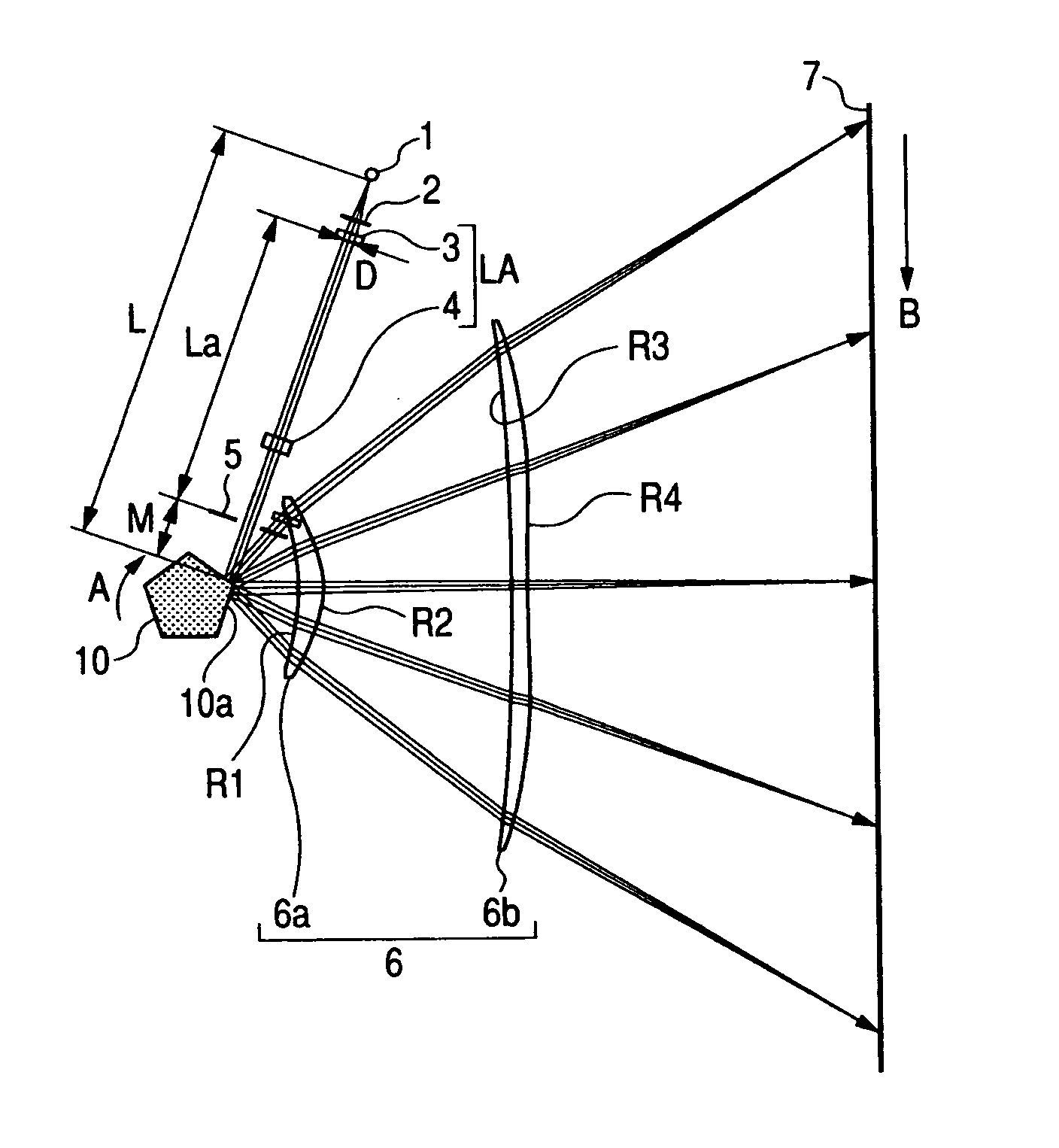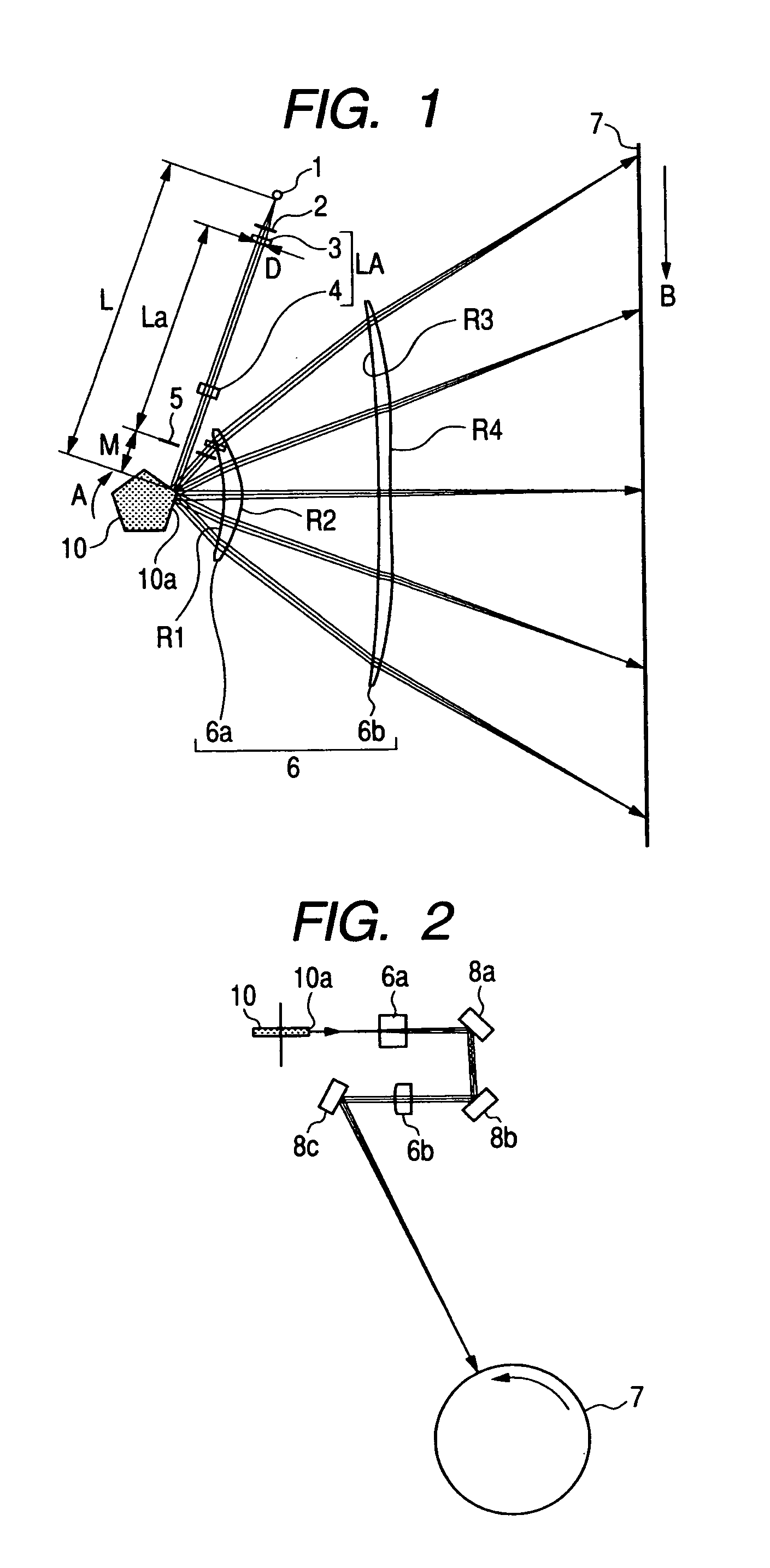Optical scanning apparatus and image forming apparatus using the same
a scanning apparatus and image technology, applied in the direction of electrographic process apparatus, instruments, printing, etc., can solve the problems of image deterioration, performance deterioration, and increase the sensitivity of the incident optical system, so as to reduce the field curvature
- Summary
- Abstract
- Description
- Claims
- Application Information
AI Technical Summary
Benefits of technology
Problems solved by technology
Method used
Image
Examples
first embodiment
[0041]FIG. 1 is a main portion sectional view of a main scanning direction (main scanning sectional view) according to a first embodiment of the present invention. FIG. 2 is a main portion sectional view of a sub scanning direction (sub scanning sectional view) according to the first embodiment of the present invention.
[0042]It should be noted that, in the description below, the sub scanning direction (Z direction) is a direction parallel to a rotational axis of a deflection unit. A main scanning section is a section in which the sub scanning direction (direction parallel to the rotational axis of the deflection unit) is a normal line. A main scanning direction (Y direction) is a direction in which light fluxes deflected for scanning by a deflection surface of the deflection unit are projected on the main scanning section. A sub scanning section is a section in which the main scanning direction is a normal line.
[0043]In the diagram, a light source unit 1 includes a semiconductor las...
second embodiment
[0168]FIG. 7 illustrates a main scanning section of an incident optical system according to a second embodiment of the present invention. In FIG. 7, the element that is the same as the element illustrated in FIG. 1 is denoted by the same reference numeral.
[0169]The second embodiment is different from the first embodiment in that the collimator lens 13 is a spherical lens that is rotationally symmetrical to the optical axis, and a shape of the exit surface of the cylindrical lens 14 in the main scanning section is noncircular. Other structures and optical actions are the same as those of the first embodiment.
[0170]In other words, in FIG. 7, a collimator lens 13 serves as a first optical element, and is formed of a glass spherical lens that can be manufactured by grinding and is a sphere including an incident surface and an exit surface rotationally symmetrical to each other.
[0171]The plastic cylindrical lens 14 serving as the second optical element 14 works so that the light flux tha...
third embodiment
[0192]FIG. 10 illustrates a main scanning section of an incident optical system according to a third embodiment of the present invention. In FIG. 10, the element that is the same as the element illustrated in FIG. 1 is denoted by the same reference symbol.
[0193]Table 4 illustrates values of the incident optical system in this embodiment.
TABLE 4rdN(670 nm)Light source (light emitting point)0.00019.2610.0000Sub scanning aperture stop4.000Collimator lens100.0003.0001.5273−14.957*43.0000.0000Cylindrical lens0.0003.0001.52730.00034.0001.0000Main scanning aperture stop22.500Deflection surface0.0000.0001.0000Aspheric surface coefficientA0.00E+00B3.05E−05C−1.00E−07D0.00E+00E0.00E+00F0.00E+00G0.00E+00*Aspheric surface
[0194]The third embodiment is different from the first embodiment described above in that a collimator lens 73 is formed of a plastic mold lens and that the distance between the collimator lens 73 and the cylindrical lens 4 is decreased compared with the first embodiment. In add...
PUM
 Login to View More
Login to View More Abstract
Description
Claims
Application Information
 Login to View More
Login to View More - R&D
- Intellectual Property
- Life Sciences
- Materials
- Tech Scout
- Unparalleled Data Quality
- Higher Quality Content
- 60% Fewer Hallucinations
Browse by: Latest US Patents, China's latest patents, Technical Efficacy Thesaurus, Application Domain, Technology Topic, Popular Technical Reports.
© 2025 PatSnap. All rights reserved.Legal|Privacy policy|Modern Slavery Act Transparency Statement|Sitemap|About US| Contact US: help@patsnap.com



